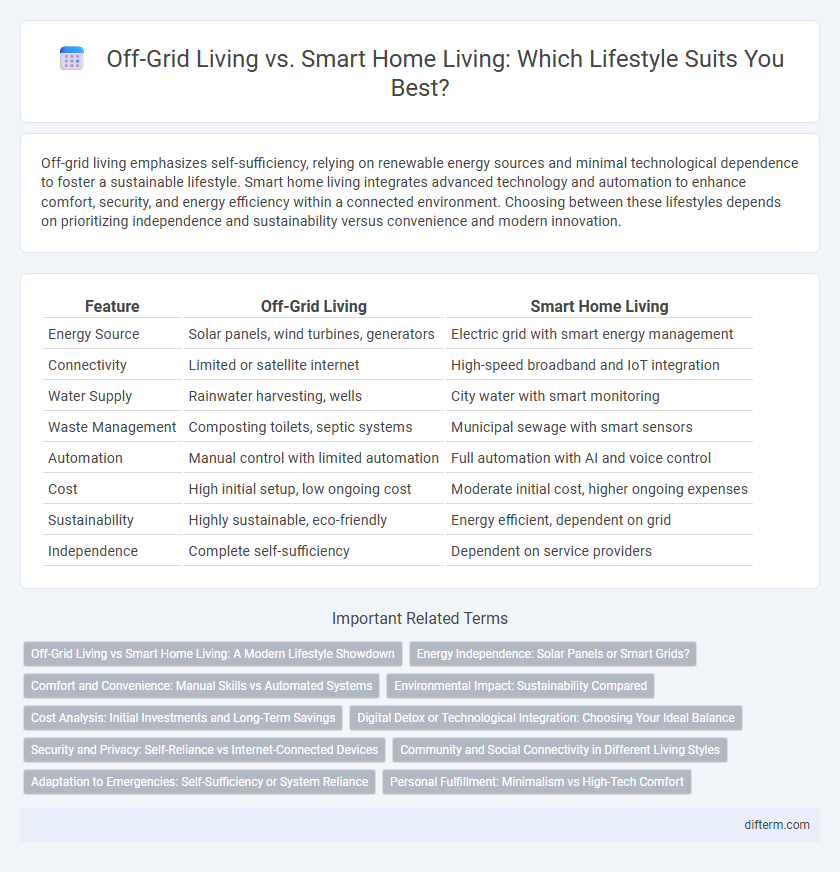Off-grid living emphasizes self-sufficiency, relying on renewable energy sources and minimal technological dependence to foster a sustainable lifestyle. Smart home living integrates advanced technology and automation to enhance comfort, security, and energy efficiency within a connected environment. Choosing between these lifestyles depends on prioritizing independence and sustainability versus convenience and modern innovation.
Table of Comparison
| Feature | Off-Grid Living | Smart Home Living |
|---|---|---|
| Energy Source | Solar panels, wind turbines, generators | Electric grid with smart energy management |
| Connectivity | Limited or satellite internet | High-speed broadband and IoT integration |
| Water Supply | Rainwater harvesting, wells | City water with smart monitoring |
| Waste Management | Composting toilets, septic systems | Municipal sewage with smart sensors |
| Automation | Manual control with limited automation | Full automation with AI and voice control |
| Cost | High initial setup, low ongoing cost | Moderate initial cost, higher ongoing expenses |
| Sustainability | Highly sustainable, eco-friendly | Energy efficient, dependent on grid |
| Independence | Complete self-sufficiency | Dependent on service providers |
Off-Grid Living vs Smart Home Living: A Modern Lifestyle Showdown
Off-grid living emphasizes energy independence, using solar panels, rainwater harvesting, and sustainable waste management systems to reduce reliance on public utilities. Smart home living integrates advanced automation technologies such as voice-activated controls, IoT devices, and energy-efficient appliances to enhance convenience and optimize power consumption. Comparing both lifestyles highlights a trade-off between self-sufficiency and technological convenience in modern sustainable living choices.
Energy Independence: Solar Panels or Smart Grids?
Energy independence in off-grid living relies heavily on solar panels paired with battery storage, enabling complete self-sufficiency and resilience from utility failures. Smart home living leverages smart grids that optimize energy consumption dynamically, enhancing efficiency while still depending on external power sources. Solar panels provide a renewable, standalone solution for uninterrupted energy, whereas smart grids offer intelligent energy management within a connected infrastructure.
Comfort and Convenience: Manual Skills vs Automated Systems
Off-grid living demands strong manual skills for tasks like water collection, energy management, and repairs, emphasizing self-reliance and hands-on problem solving. Smart home living leverages automated systems such as voice-controlled devices, smart thermostats, and remote security, providing seamless comfort and enhanced convenience. The contrast lies in off-grid's tactile engagement versus smart homes' digital efficiency in managing daily routines.
Environmental Impact: Sustainability Compared
Off-grid living significantly reduces reliance on conventional energy grids by utilizing renewable energy sources such as solar panels and wind turbines, leading to a lower carbon footprint and enhanced sustainability. In contrast, smart home living increases energy efficiency through automated systems and smart appliances that optimize power consumption, yet it still depends largely on traditional energy infrastructure. Both lifestyles promote sustainability, but off-grid living offers greater environmental benefits by minimizing dependency on fossil fuels and reducing greenhouse gas emissions directly.
Cost Analysis: Initial Investments and Long-Term Savings
Off-grid living requires substantial initial investments in solar panels, batteries, water collection systems, and backup generators, whereas smart home living involves costs for automation devices, energy-efficient appliances, and home network installation. Long-term savings in off-grid living stem from energy independence and reduced utility bills but may include maintenance expenses for renewable energy systems. Smart homes offer ongoing utility cost reductions through optimized energy use and predictive maintenance, often balancing higher upfront technology costs with sustained efficiency gains.
Digital Detox or Technological Integration: Choosing Your Ideal Balance
Off-grid living promotes a digital detox by minimizing reliance on technology, fostering self-sufficiency and deeper connection with nature. Smart home living emphasizes technological integration, offering automation and convenience through connected devices that enhance daily comfort. Selecting the ideal balance depends on prioritizing either a tech-free environment for mental clarity or embracing smart innovations for efficiency and connectivity.
Security and Privacy: Self-Reliance vs Internet-Connected Devices
Off-grid living enhances security and privacy by minimizing reliance on internet-connected devices, reducing vulnerability to hacking and data breaches. Smart home living offers advanced security features through remote monitoring and automated alerts but introduces potential risks from cyber intrusions and data privacy concerns. Balancing self-reliance with technology requires careful consideration of how connectivity impacts personal safety and information protection.
Community and Social Connectivity in Different Living Styles
Off-grid living fosters tight-knit, local communities where face-to-face interactions and shared resources strengthen social bonds. Smart home living, supported by advanced technology and digital networks, extends social connectivity beyond physical boundaries, enabling virtual communities and remote collaboration. Both lifestyles offer unique social dynamics, with off-grid focusing on local interdependence and smart homes emphasizing digital engagement.
Adaptation to Emergencies: Self-Sufficiency or System Reliance
Off-grid living emphasizes self-sufficiency through renewable energy sources, water harvesting, and food production, enabling individuals to maintain autonomy during emergencies without external support. Smart home living relies on interconnected systems and automated technologies powered by centralized grids, which may become vulnerable during power outages or cyberattacks. Choosing off-grid adaptation fosters resilience by minimizing dependence on external infrastructure, whereas smart homes optimize convenience but require contingency plans for system failures.
Personal Fulfillment: Minimalism vs High-Tech Comfort
Off-grid living emphasizes minimalism by fostering self-sufficiency and a deep connection with nature, enhancing personal fulfillment through simplicity and reduced dependence on technology. Smart home living offers high-tech comfort with advanced automation, convenience, and energy efficiency, appealing to individuals seeking modern luxury and seamless lifestyle integration. Both lifestyles cater to different definitions of personal fulfillment, balancing simplicity and technological sophistication.
off-grid living vs smart home living Infographic

 difterm.com
difterm.com